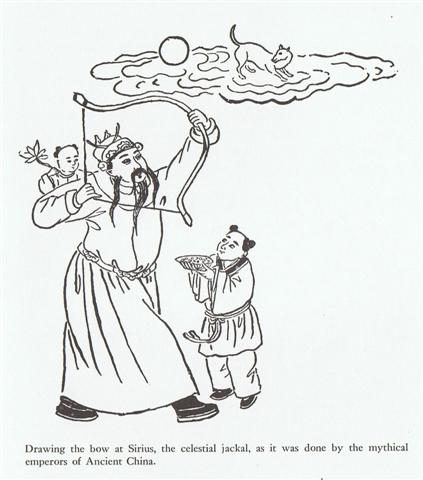388. The day number for the ika hiku (tail fish), as Metoro might have said if he had been given the opportunity to 'read' also the G text for Bishop Jaussen on Tahiti, equals 325 - 144 = 181 (alluding to the last day of June and the permanent position of heliacal Sirius):
Day 325 for November 21 could allude to 32 * 5 = 160 = 161 (June 10) - 1. ... Midsummer is the flowering season of the oak, which is the tree of endurance and triumph, and like the ash is said to 'court the lightning flash'. Its roots are believed to extend as deep underground as its branches rise in the air - Virgil mentions this - which makes it emblematic of a god whose law runs both in Heaven and in the Underworld ... The month, which takes its name from Juppiter the oak-god, begins on June 10th and ends of July 7th. Midway comes St. John's Day, June 24th, the day on which the oak-king was sacrificially burned alive. The Celtic year was divided into two halves with the second half beginning in July, apparently after a seven-day wake, or funeral feast, in the oak-king's honour ... And then we can recognize the position of the reversed manu rere as day 265 corresponding to autumn equinox (September 22). 325 (= 13 * 25) was surely a Sign for the Julian spring equinox: ... When Julius Caesar established his calendar in 45 BC he set March 25 (3-25) as the spring equinox. Since a Julian year (365.25 days) is slightly longer than an actual year the calendar drifted with respect to the equinox, such that the equinox was occurring on about 21 March in AD 300 and by AD 1500 it had reached 11 March. This drift induced Pope Gregory XIII to create a modern Gregorian calendar. The Pope wanted to restore the edicts concerning the date of Easter of the Council of Nicaea of AD 325 ... And 84 + 265 = 349 could then be interpreted as the day before the very last in a regular year: ... The Julian calendar introduced in 46 B.C. by Caesar changed the earlier 355 day long calendar by increasing the length of 7 of the months:
The ordinary year in the previous Roman calendar consisted of 12 months, for a total of 355 days. In addition, a 27-day intercalary month, the Mensis Intercalaris, was sometimes inserted between February and March. This intercalary month was formed by inserting 22 days after the first 23 or 24 days of February; the last five days of February, which counted down toward the start of March, became the last five days of Intercalaris. The net effect was to add 22 or 23 days to the year, forming an intercalary year of 377 or 378 days ... If Gb8-5 was read as 13 * 25 = 325, then the end of side b would correspond to 14 * 25 = 350 and the place of heliacal Aldebaran (Ga1-4) would be day 350 + 1 + 4 = 355. Hyadum II had no glyph. On Tahiti the 'star at the end' (Ana-muri) was a name for Aldebaran. At the 'foot' of Aldebaran was the 'place for tattooing', a well found comment because south of the equator (at the foot instead of at the head) heliacal Aldebaran was at the end and not at the beginning of summer. 23 in February 23 could correspond to the Hawaiian circuit of 23 days for the Lono (Rongo) effigy, before the winter solstice, a season when 'land' was not in sight and there was 'water' everywhere. ... In the morning of the world, there was nothing but water. The Loon was calling, and the old man who at that time bore the Raven's name, Nangkilstlas, asked her why. 'The gods are homeless', the Loon replied. 'I'll see to it', said the old man, without moving from the fire in his house on the floor of the sea. Then as the old man continued to lie by his fire, the Raven flew over the sea. The clouds broke. He flew upward, drove his beak into the sky and scrambled over the rim to the upper world. There he discovered a town, and in one of the houses a woman had just given birth ...
... In the deep night before the image [of Lono] is first seen, there is a Makahiki ceremony called 'splashing-water' (hi'uwai). Kepelino tells of sacred chiefs being carried to the water where the people in their finery are bathing; in the excitement created by the beauty of their attire, 'one person was attracted to another, and the result', says this convert to Catholicism, 'was by no means good'. At dawn, when the people emerged from their amorous sport, there standing on the beach was the image of Lono. White tapa cloth and skins of the ka'upu bird hang from the horizontal bar of the tall crosspiece image. The ka'upu is almost certainly the albatross, a migratory bird that appears in the western Hawaiian chain - the white Lanyon albatross at Ni'ihau Island - to breed and lay eggs in October-November, or the beginning of the Makahiki season ... Hyadum II was at the first position on side a of the tablet and by adding 181 right ascension days we will find the first glyph of another 'door', viz. that in Ophiuchi (the serpent - water - carrier):
|
||||||||||||||||||||||||||||||||||||||||||||||||||||||||||||||||||||||||||||||||||||||||||||||||||


